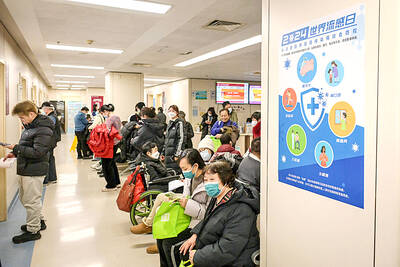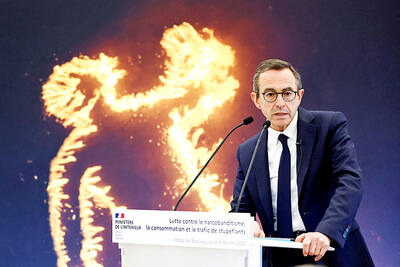An arid expanse of California desert at the southern end of the San Andreas Fault is being wired with high-tech sensors that scientists hope will tell them when the state’s sleeping giant could awaken.
The effort could not be more timely. For the past week, a swarm of more than 250 earthquakes has jiggled the desert where the first new seismic instruments were installed earlier this year.
“Even the smallest little bump shows up there,” said Bill Curtis, demonstrating the sensitivity of the new monitors with a foot-stomp that created telltale squiggles on a connected laptop.
Curtis, a field technician with the US Geological Survey (USGS), was satisfied that the newly installed instruments work.
Of the more than 300 known earthquake faults that crisscross California like a maze, the San Andreas is the premier fault line.
The nearly 1,287km fault runs from a peninsula just north of San Francisco to the Salton Sea, 200km southeast of Los Angeles.
In the first large-scale monitoring upgrade to one of the Earth’s most infamous cracks, scientists are showing unprecedented attention to the forgotten southernmost section, which has not ruptured in more than three centuries and is thought to be the most ripe to break.
Crews are hopscotching the southern San Andreas, burying motion sensors within 4.8km of the fault in hopes of catching the next “Big One.”
“We’re data-poor here,” said Ken Hudnut, a USGS geophysicist. “We don’t have the past record to tell us what’s going to happen.”
The USGS maintains a sprawling network of 300 seismic stations across the state. They automatically estimate a temblor’s size when the ground heaves and beam real-time data to a central hub in Pasadena, alerting that an earthquake has hit.
Since the southern San Andreas poses a significant danger to the roughly 20 million residents living near it, scientists decided to pepper the fault with 11 new seismic stations and update six old ones.
Each San Andreas station contains two sensors to measure speed and acceleration as well as a data-logger and a mini-computer that can process seismic signals without having to rely on the central hub.
The entire southern end upgrade will cost more than US$500,000, financed by a USGS grant. The instruments cost US$40,000 plus an extra US$15,000 for solar panels, antennas, construction and labor.
On a recent afternoon, USGS seismologist Doug Given and a team of technicians tested seismic equipment near the fast-growing Coachella Valley, a desert playground for golfers and sun-worshippers.
Surrounding them were the Mecca Hills, a maze of eroded canyons and badlands lifted up by the nonstop geologic bump and grind of the North American and Pacific plates.
The new sensor was installed near a dry creek bed on federal property next to a private mining company. The location had a line of sight to a communication tower, but it was remote enough that four-wheel drive was needed.
“It’s kind of like parking a Cadillac Escalade out here and leaving it,” Given said of the costly seismic equipment.
By clustering sensors along the southern edge, scientists hope to get faster readings of when quakes occur on the San Andreas and to better understand the science behind how faults break.
Eventually, they hope the sensors could be incorporated into an early warning system in Southern California — a goal that is still years away.
“What we’re after is measuring the ground motion,” Given said. “The closer you are to the source, the sooner you know an earthquake has begun.”
Any time a small fault next to a bigger one breaks, it slightly increases the chance of a larger quake, but that risk rapidly decreases with time.
“That doesn’t mean this section of the San Andreas is the next to go,” Hudnut said. “The San Andreas likes to demonstrate how irregular its behavior can be.”
The work recently paid off. Newly installed seismic stations along the eastern shores of the Salton Sea were among the first to pick up the recent swarm, which broke a fault perpendicular to the San Andreas.
The sensors have been sending back valuable data that scientists are only beginning to analyze.

RIGHTS FEARS: A protester said Beijing would use the embassy to catch and send Hong Kongers to China, while a lawmaker said Chinese agents had threatened Britons Hundreds of demonstrators on Saturday protested at a site earmarked for Beijing’s controversial new embassy in London over human rights and security concerns. The new embassy — if approved by the British government — would be the “biggest Chinese embassy in Europe,” one lawmaker said earlier. Protester Iona Boswell, a 40-year-old social worker, said there was “no need for a mega embassy here” and that she believed it would be used to facilitate the “harassment of dissidents.” China has for several years been trying to relocate its embassy, currently in the British capital’s upmarket Marylebone district, to the sprawling historic site in the

A deluge of disinformation about a virus called hMPV is stoking anti-China sentiment across Asia and spurring unfounded concerns of renewed lockdowns, despite experts dismissing comparisons with the COVID-19 pandemic five years ago. Agence France-Presse’s fact-checkers have debunked a slew of social media posts about the usually non-fatal respiratory disease human metapneumovirus after cases rose in China. Many of these posts claimed that people were dying and that a national emergency had been declared. Garnering tens of thousands of views, some posts recycled old footage from China’s draconian lockdowns during the COVID-19 pandemic, which originated in the country in late

French police on Monday arrested a man in his 20s on suspicion of murder after an 11-year-old girl was found dead in a wood south of Paris over the weekend in a killing that sparked shock and a massive search for clues. The girl, named as Louise, was found stabbed to death in the Essonne region south of Paris in the night of Friday to Saturday, police said. She had been missing since leaving school on Friday afternoon and was found just a few hundred meters from her school. A police source, who asked not to be named, said that she had been

BACK TO BATTLE: North Korean soldiers have returned to the front lines in Russia’s Kursk region after earlier reports that Moscow had withdrawn them following heavy losses Ukrainian President Volodymyr Zelenskiy on Friday pored over a once-classified map of vast deposits of rare earths and other critical minerals as part of a push to appeal to US President Donald Trump’s penchant for a deal. The US president, whose administration is pressing for a rapid end to Ukraine’s war with Russia, on Monday said he wanted Ukraine to supply the US with rare earths and other minerals in return for financially supporting its war effort. “If we are talking about a deal, then let’s do a deal, we are only for it,” Zelenskiy said, emphasizing Ukraine’s need for security guarantees